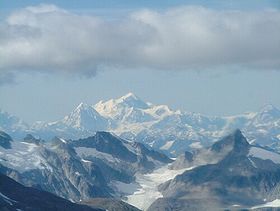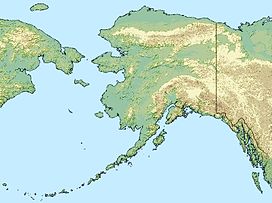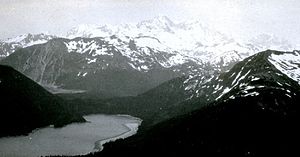- Mount Fairweather
-
Mount Fairweather Tsalxhaan 
Fairweather from Glacier Bay, Sept. 2004Elevation 4,671 m (15,325 ft) [1] Prominence 3,956 m (12,979 ft) [1]
Ranked 26thListing List of Ultras in Canada List of Ultras in the United States Location Location on Alaska/B.C. border Location Glacier Bay National Park and Preserve, Alaska / Stikine Region, British Columbia Range Fairweather Range Coordinates 58°54′23″N 137°31′36″W / 58.90639°N 137.52667°WCoordinates: 58°54′23″N 137°31′36″W / 58.90639°N 137.52667°W[2] Topo map NTS 114I/13 Climbing First ascent June 8, 1931 by Allen Carpé and Terris Moore Easiest route glacier/snow/ice climb Mount Fairweather (officially gazetted as Fairweather Mountain in Canada[2] but referred to as Mount Fairweather), is one of the world's highest coastal mountains at 4,671 metres (15,325 feet.) It is located 20 km (12 mi) east of the Pacific Ocean on the border of Alaska, United States and western British Columbia, Canada. Most of the mountain lies within Glacier Bay National Park and Preserve in the City and Borough of Yakutat, Alaska (USA), though the summit borders Tatshenshini-Alsek Provincial Park, British Columbia (Canada), making it the highest point in that province. It is also designated as Boundary Peak 164 or as US/Canada Boundary Point #164.[3][4]
The mountain was named on May 3, 1778 by Captain James Cook,[5] apparently for the unusually good weather encountered at the time. The name has been translated into many languages. It was called "Mt. Beautemps" by La Perouse (1786, atlas), "Mte. Buen-tiempo" by Galiano (1802, map 3), "Gor[a]-Khoroshy-pogody" on Russian Hydrographic Dept. Chart 1378 in 1847, and "G[ora] Fayerveder" by Captain Tebenkov (1852, map 7), Imperial Russian Navy. It was called "Schönwetterberg" by Constantin Grewink in 1850 and "Schönwetter Berg" by Justus Perthes in 1882.[6]
Fairweather was first climbed in 1931 by Allen Carpé and Terris Moore.[6]
Geography
Mount Fairweather is located right above Glacier Bay in the Fairweather Range of the Saint Elias Mountains. Mount Fairweather also marks the northwest extremity of the Alaska Panhandle.
Like many large mountains in the St. Elias Mountains, Mount Fairweather has great vertical relief due to its dramatic rise from Glacier Bay. However, due to poor weather in the area, this effect is usually obscured with the clouds which often hides the summit from view.
Known in the Tlingit language as Tsalxhaan, it is said this mountain and Yaas'éit'aa Shaa (Mt. St. Elias) were originally next to each other but had an argument and separated. Their children, the mountains in between the two peaks, are called Tsalxhaan Yatx'i (Children of Tsalxaan.)[citation needed]
Weather
Despite its name, Mount Fairweather has generally harsh weather conditions. It receives over 100 inches (254 cm) of precipitation each year (mostly snow) and sees temperatures of around -50°F (-46°C).[citation needed]
Climbing history
- 1931 Allen Carpe and Terris Moore summited via the Southeast Ridge on June 8, 1931[6]
- 1958 Paddy Sherman and 7 other Canadians reached the summit via the SE Ridge on June 26, 1958.[7]
- 1968 West Ridge, Loren Adkins, Walter Gove, Paul Myhre, John Neal and Kent Stokes - summit reached June 12, 1968[8]
- 1973 Southwest Ridge, Peter Metcalf, Henry Florschutz, Toby O'Brien and Lincoln Stoller. Summit reached on 10 July 1973.[9]
Further reading
- Sherman, Paddy (1966). Cloud Walkers. MacMillan. ASIN B000HZ4UNG. ISBN 0916890791.
- Metcalf, Peter (1974). "The Southwest Ridge of Fairweather". American Alpine Journal 1974 (New York, NY, USA: American Alpine Club) 19 (48): 19–22. ISBN 9780930410711.
See also
- 4000 meter peaks of Alaska
- 4000 metre peaks of Canada
- 4000 meter peaks of North America
- 4000 meter peaks of the United States
- Mountain peaks of Alaska
- Mountain peaks of Canada
- Mountain peaks of North America
- Mountain peaks of the United States
- NOAA Ship Fairweather
- List of Boundary Peaks of the Alaska – British Columbia/Yukon border
References
- ^ a b "Fairweather Mountain". Bivouac.com. http://www.bivouac.com/MtnPg.asp?MtnId=10. Retrieved 2008-12-27.
- ^ a b "Fairweather Mountain". BC Geographical Names. http://apps.gov.bc.ca/pub/bcgnws/names/38638.html. Retrieved 2010-07-13.
- ^ http://www.peakbagger.com/peak.aspx?pid=566
- ^ http://www.peakbagger.com/peak.aspx?pid=27305
- ^ Terris Moore, "Mount Fairweather, Correction", American Alpine Journal 1982, p. 139. He cites Cook and King Voyage to the Pacific Ocean, Volume II, Admiralty, London, 1784, p. 345.
- ^ a b c "Mount Fairweather". Geographic Names Information System, U.S. Geological Survey. http://geonames.usgs.gov/pls/gnispublic/f?p=gnispq:3:::NO::P3_FID:1420601. Retrieved 2004-07-09.
- ^ Metcalf, Peter (1974). "The Southwest Ridge of Fairweather". American Alpine Journal 1974 (New York, NY, USA: American Alpine Club) 19 (48): 19. ISBN 9780930410711.
- ^ Gove, Walter; Loren Adkins (1969). "The West Ridge of Mount Fairweather". American Alpine Journal 1969 (Philadelphia, PA, USA: American Alpine Club) 16 (43): 390.
- ^ Metcalf, Peter (1974). "The Southwest Ridge of Fairweather". American Alpine Journal 1974 (New York, NY, USA: American Alpine Club) 19 (48): 19–22. ISBN 9780930410711.
Categories:- Landforms of Hoonah–Angoon Census Area, Alaska
- Mountains of British Columbia
- Mountains of Alaska
- Saint Elias Mountains
- United States National Park high points
- Landforms of Yakutat City and Borough, Alaska
- Glacier Bay National Park and Preserve
- Canada–United States border
- International mountains of North America
Wikimedia Foundation. 2010.


